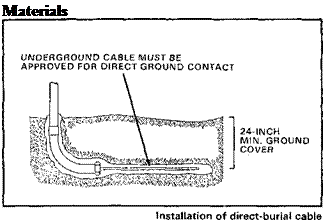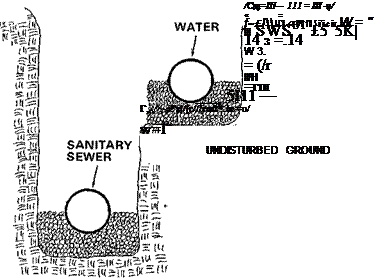UTILITIES/UTILITY EASEMENTS
One of the most prohibitive local residential land development regulations requires placement of all utilities in public rights-of-way. A viable, less costly alternative is installation of utilities outside of the ROW in easements.
Following are guidelines for utilities and utility easements:
• Place utilities in easements instead of rights-of-way where appropriate.
• Use plastic piping in underground gas systems.
• Install direct buried phone, cable TV and electric lines.
• Use common trenching for multiple utility installations.
![]() Utility easements are an acceptable procedure in many areas of the country. Benefits of easements compared to rights-of-way are detailed in the Streets section. Specific to utilities, however, an easement often allows placement of a line in the shortest available path, decreasing the overall length of the line and reducing costs.
Utility easements are an acceptable procedure in many areas of the country. Benefits of easements compared to rights-of-way are detailed in the Streets section. Specific to utilities, however, an easement often allows placement of a line in the shortest available path, decreasing the overall length of the line and reducing costs.

Home owners maintain and use easement areas, saving the locality money and adding land for the homeowners’ enjoyment. Legal rights to the easement land are assigned to the community, utility companies, and home owners.
 Several non-traditional materials for use in sanitary sewers, stormwater systems, and water service are discussed in earlier sections. Gas, electric, and cable TV can also use more effective, less costly materials.
Several non-traditional materials for use in sanitary sewers, stormwater systems, and water service are discussed in earlier sections. Gas, electric, and cable TV can also use more effective, less costly materials.
Plastic piping, usually polyvinyl chloride (PVC) or polyethylene (PE), is used in underground gas piping systems in lieu of the traditional black or galvanized steel, reducing costs and increasing ease of installation and corrosion resistance.
Direct-burial cable can be used for cable TV, phone, and electric lines, eliminating the need for a covering or conduit to serve as a protective sleeve. The National Electric Code (NEC) permits direct-burial cable when a minimum soil cover, or equivalent protection, is provided.
![]() Common trenching of different combinations of utilities is becoming more acceptable. Common trenching of sanitary sewer and water lines is permitted by the major U. S. model building code organizations – ICBO, BOCA, SBCCI and CABO. Approximately $5 per foot can be saved in installation costs of main lines, with a smaller savings of $2 per foot on service laterals. The water line is generally placed at least 12 inches above the sewer line, with a minimum horizontal separation of 18 inches. However, due to improved reliability in materials and construction techniques,
Common trenching of different combinations of utilities is becoming more acceptable. Common trenching of sanitary sewer and water lines is permitted by the major U. S. model building code organizations – ICBO, BOCA, SBCCI and CABO. Approximately $5 per foot can be saved in installation costs of main lines, with a smaller savings of $2 per foot on service laterals. The water line is generally placed at least 12 inches above the sewer line, with a minimum horizontal separation of 18 inches. However, due to improved reliability in materials and construction techniques,

 |
|
Common water/sewer trench
local codes are beginning to recognize that minimum separation distances are unnecessary.
Common trenching is used successfully with electric, telephone, cable TV, and gas lines. The installation cost is reduced substantially if three or four utility companies share trenching expenses.
The city of Tacoma, Washington, estimates common trenching in residential areas reduces costs, an average of 97 cents per foot where electric, telephone, and cable TV are installed in the same trench. Seattle, Washington, reports savings of 40 percent to 60 percent.






Leave a reply